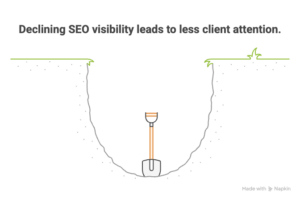As search experiences evolve, agencies managing local SEO for clients are feeling the shift: fewer clicks, disappearing Maps packs, and AI Overviews stealing attention. But while everyone is debating whether local SEO is “dead,” smart agencies know this isn’t the end. It’s a pivot. And those who adapt now will own the next era of discovery.
This piece breaks down where things are heading, what it means for your local clients, and how agencies need to rewire their strategy to stay visible in an AI-first world.
A Changed Search Landscape.
Search in 2025 looks nothing like it did even two years ago. Users aren’t scanning pages of blue links anymore. They’re asking questions, getting summaries, and expecting personalized, immediate answers. Platforms like ChatGPT, Google’s AI Overviews, and Perplexity are training users to skip the scroll and go straight to the answer.
And that has resulted in Local service pages and Maps listings being pushed further down. Zero-click searches are rising. Organic traffic is declining, even when technical SEO is on point.
But the AI models generating these results aren’t inventing answers from thin air. They’re pulling from local sources, business profiles, reviews, and structured content. Which means visibility is still up for grabs, just not in the way we’re used to.

This Isn’t a Threat. It’s a Shift.
If you run local SEO for clients, you’ve likely already felt the shift. Fewer clicks from high-intent queries. Less Maps exposure. More clients are asking, “Why are my numbers down?”
But here’s the thing: AI search still needs sources. It still needs structure. It still needs credible, relevant, local content to build answers. And that’s where your opportunity lies.
What used to be about ranking is now about being referenced. The best-positioned businesses are those whose data is clean, content is credible, and their presence is consistent across every digital touchpoint.
Local SEO Won’t Save You. Answer Optimization Will.
Chasing rankings or keyword stuffing isn’t going to work any longer. Now, you need to make your client’s business trustworthy enough so that LLMs cite it. Users aren’t scrolling through options anymore; they’re looking for the one that gets mentioned in the summary. If your client’s not showing up there, they’re not part of the conversation.
Here’s what agencies need to focus on:
- Structured data is key. AI depends on clarity. Use proper schema to describe services, location, and business details.
- Trust signals matter more than ever. Clean NAP data, strong reviews, and consistent local presence help build authority.
- Relevance is contextual now. It’s not just about what your client says, it’s about what’s being said around them.
- Great user experience still matters. AI might reduce clicks, but the ones you get are high intent. Make sure your site converts.
So, What Should You Be Doing Right Now?
1. Fix Discovery First
Discovery in the AI era is not about crawlability anymore. It is about structure, clarity, and distribution. AI tools do not crawl the web the way Google used to. They pull answers from structured, reliable data on trusted platforms.
This makes the basics critical:
- A complete and optimized Google Business Profile
- Consistent NAP details across every directory
- A website that clearly explains what the business does, where it operates, and who it serves
Schema markup is essential. It should include services, service areas, reviews, and FAQs. These signals help AI systems understand and surface your client in answers.
But the schema alone is not enough. AI also looks for consistent mentions across directories, forums, review sites, and local blogs. These repeated signals build credibility and help AI decide which businesses to include in results.
Start with a full audit of your client’s presence. Fix outdated details. Align inconsistent information. Keep everything updated. The cleaner and more structured the data, the easier it is for both customers and AI to find and trust the business.
2. Treat Experience as the New Conversion Funnel
Clicks may be dropping, but intent is not. People still want to take action; they are just doing it from AI summaries, business cards, or zero-click results.
This means the website is no longer the only conversion point. Every touchpoint matters. If the Google Business Profile is incomplete, booking links are broken, or the site is slow on mobile, business will be lost.
Focus on optimizing every interaction:
- Fast mobile speed
- Clear CTAs
- Local landing pages
- Smooth booking flows
Non-website channels matter too. Encourage reviews, build loyalty programs, and stay active in local communities. These signals now influence whether customers decide to act.
3. Shift from Rankings to Recognition
Search engines used to reward keywords and technical SEO. AI rewards context and clarity. Ranking for a single keyword is no longer enough. Businesses now need topical depth, which means answering not only the main question but also the related ones that help people make confident decisions.
AI also looks for external validation. Fresh reviews, consistent mentions, and community trust all carry weight. If content is vague, outdated, or disconnected from how people actually search, the business will be overlooked.
4. Make Every Click Count
The clicks you do get will come from high-intent users. Do not waste them. Make sure the site loads quickly on mobile, remove unnecessary form fields, and test every conversion flow. Track where users drop off and fix those points. You are no longer optimizing for casual browsing, but for decision-making.
Pay attention to image search as well. Google is filtering out low-quality AI images, and weak visuals can reduce visibility. Every element, from photos to calls-to-action, is now part of the conversion journey.
5. Change What You Measure
Rankings and traffic reports no longer tell the full story. Visibility today is about how often a business is referenced, recognized, or chosen across platforms.
Track the metrics that matter:
- Google Business Profile actions like calls, bookings, and direction requests
- Review engagement
- Mentions on third-party sites
- Appearances in AI Overviews
This is a shift from volume to value. Even with fewer clicks, if calls and bookings are rising, the strategy is working.
6. What to Tell Clients
Clients do not need a technical breakdown of AI. They need clarity.
Tell them this: search is changing, and traffic may dip, but visibility and conversions can still grow if the right adjustments are made. The goal is no longer to chase page-one rankings. The goal is to be the business that AI trusts enough to recommend. That is more challenging, but it is also far more valuable.
Final Thoughts
Local SEO is not disappearing; it is evolving.
Trust, clarity, and consistency have always mattered, but AI has made them essential. The businesses that will win are the ones with accurate data, strong reviews, fresh content, and a presence across every trusted platform.
The next customer is not scrolling through ten search results. They are asking a question and seeing one answer.
Your job is to make sure that the answer is for your client.


